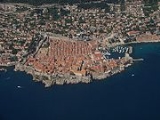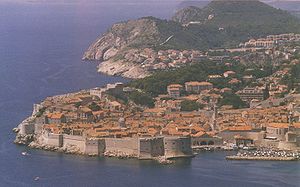
Atlantska Plovidba
Encyclopedia
Atlantska plovidba d.d. or Atlantska plovidba is a Croatian shipping company
. Founded in 1955 in Dubrovnik
, the company works mostly in the dry bulk
and heavy lift
markets, serving both domestic and international clients
 The history of Atlantska plovidba is tied closely to that of Dubrovnik. At the outset of World War II
The history of Atlantska plovidba is tied closely to that of Dubrovnik. At the outset of World War II
, the fleet of Dubrovnik consisted of about , and represented about half of Yugoslavia
's merchant fleet. In addition, Dubrovnik had a financial stake in 30% to 60% of the remaining Yugoslav steamship companies. However, by the end of World War II, only nine ships totalling survived.
These nine ships were nationalized and given to the Yugoslav
company "Jugolinija" based in Rijeka
, leaving Dubrovnik with no merchant fleet After several years, citizens of Dubrovnik petitioned Yugoslavia's State Executive Committee to denationalize the fleet. The state agreed, and as a result, Atlantska plovidba was founded May 27, 1955
In the beginning, the company was given seven tramp steamers totaling . These ships burnt coal, were capable of six to eight knots, and were, on average, 35 years old. The company took delivery of the ships between December 19, 1955 and 1957.
The early post-war years were very profitable for the company, allowing it to reinvest in itself. At the same time, the Yugoslavian government became interested in building ships. This combination allowed Atlantska Plovidba to build a fleet of 20 ships of a combined by 1965. In addition to tripling its tonnage, the newbuilding programme cut the average ship age to 17 years.
After building several new ships at Trieste
, and the shipyards at Split
and Trogir
, Atlantska plovidba scrapped the last of the original nine ships in 1970. By 1975, the average ship age in the fleet was down to 7.5 years. In 1976, Atlantska plovidba built their largest dry cargo ship, at , and in the 1980s, added 5 panamax
vessels, increasing fleet tonnage by .
From 1991 to 1995, the company's operations were disturbed by the Croatian War of Independence
. During the war, the Croatian ship registry was not recognized, and for a time, Atlantska Plovidba registered its ships with the Maltese Registry
. At the conclusion of the war, Atlantska Plovidba, was second only to a state-owned company in reregistering its ships under the Croatian flag
By 2001, the fleet had a capacity of and the company started to diversify its operations into other industries. Early on, it ventured into shipping agency and travel agency, and later into hotels and airlines. The company owns three hotels, the Hilton Imperial, Hotel Lapad, and Grand Hotel on the island of Lopud. In 2005, the company founded a charter airline company.
The company prides itself on its contribution to maritime education in Croatia. It helped finance and open three institutions of higher learning, the Dubrovnik Maritime Nautical College in 1959, the Dubrovnik Maritime Engineer College in 1964, and Dubrovnik Maritime University in 1986.
s, heavy lift ship
s, and Coastal trading vessel
s.
The company owns 14 bulk carriers from to . These ships operate worldwide as trampers. Eight of them are capable of unloading their own cargo.
The company also owns 4 heavy lift ships, capable of lifting loads up to 500 metric tons. These ships each have a capacity of and operate worldwide.
The third type of ship the company owns are small coastal trading vessels. It owns three of these type, designed for dry cargo. These ships operate exclusively in the Mediterranean Sea
and are not capable of self-unloading.
Ship transport
Ship transport is watercraft carrying people or goods . Sea transport has been the largest carrier of freight throughout recorded history. Although the importance of sea travel for passengers has decreased due to aviation, it is effective for short trips and pleasure cruises...
. Founded in 1955 in Dubrovnik
Dubrovnik
Dubrovnik is a Croatian city on the Adriatic Sea coast, positioned at the terminal end of the Isthmus of Dubrovnik. It is one of the most prominent tourist destinations on the Adriatic, a seaport and the centre of Dubrovnik-Neretva county. Its total population is 42,641...
, the company works mostly in the dry bulk
Bulk cargo
Bulk cargo is commodity cargo that is transported unpackaged in large quantities. This cargo is usually dropped or poured, with a spout or shovel bucket, as a liquid or as a mass of relatively small solids , into a bulk carrier ship's hold, railroad car, or tanker truck/trailer/semi-trailer body...
and heavy lift
Heavy lift ship
A heavy lift ship is a vessel designed to move very large loads that cannot be handled by normally equipped ships. They are of two types: semi-submerging capable of lifting another ship out of the water and transporting it; and vessels that augment unloading facilities at inadequately equipped...
markets, serving both domestic and international clients
History

World War II
World War II, or the Second World War , was a global conflict lasting from 1939 to 1945, involving most of the world's nations—including all of the great powers—eventually forming two opposing military alliances: the Allies and the Axis...
, the fleet of Dubrovnik consisted of about , and represented about half of Yugoslavia
Yugoslavia
Yugoslavia refers to three political entities that existed successively on the western part of the Balkans during most of the 20th century....
's merchant fleet. In addition, Dubrovnik had a financial stake in 30% to 60% of the remaining Yugoslav steamship companies. However, by the end of World War II, only nine ships totalling survived.
These nine ships were nationalized and given to the Yugoslav
Yugoslavia
Yugoslavia refers to three political entities that existed successively on the western part of the Balkans during most of the 20th century....
company "Jugolinija" based in Rijeka
Rijeka
Rijeka is the principal seaport and the third largest city in Croatia . It is located on Kvarner Bay, an inlet of the Adriatic Sea and has a population of 128,735 inhabitants...
, leaving Dubrovnik with no merchant fleet After several years, citizens of Dubrovnik petitioned Yugoslavia's State Executive Committee to denationalize the fleet. The state agreed, and as a result, Atlantska plovidba was founded May 27, 1955
In the beginning, the company was given seven tramp steamers totaling . These ships burnt coal, were capable of six to eight knots, and were, on average, 35 years old. The company took delivery of the ships between December 19, 1955 and 1957.
The early post-war years were very profitable for the company, allowing it to reinvest in itself. At the same time, the Yugoslavian government became interested in building ships. This combination allowed Atlantska Plovidba to build a fleet of 20 ships of a combined by 1965. In addition to tripling its tonnage, the newbuilding programme cut the average ship age to 17 years.
After building several new ships at Trieste
Trieste
Trieste is a city and seaport in northeastern Italy. It is situated towards the end of a narrow strip of land lying between the Adriatic Sea and Italy's border with Slovenia, which lies almost immediately south and east of the city...
, and the shipyards at Split
Split (city)
Split is a Mediterranean city on the eastern shores of the Adriatic Sea, centered around the ancient Roman Palace of the Emperor Diocletian and its wide port bay. With a population of 178,192 citizens, and a metropolitan area numbering up to 467,899, Split is by far the largest Dalmatian city and...
and Trogir
Trogir
Trogir is a historic town and harbour on the Adriatic coast in Split-Dalmatia County, Croatia, with a population of 12,995 and a total municipality population of 13,322 . The historic city of Trogir is situated on a small island between the Croatian mainland and the island of Čiovo...
, Atlantska plovidba scrapped the last of the original nine ships in 1970. By 1975, the average ship age in the fleet was down to 7.5 years. In 1976, Atlantska plovidba built their largest dry cargo ship, at , and in the 1980s, added 5 panamax
Panamax
Panamax and New Panamax are popular terms for the size limits for ships traveling through the Panama Canal. Formally, the limits and requirements are published by the Panama Canal Authority titled "Vessel Requirements"...
vessels, increasing fleet tonnage by .
From 1991 to 1995, the company's operations were disturbed by the Croatian War of Independence
Croatian War of Independence
The Croatian War of Independence was fought from 1991 to 1995 between forces loyal to the government of Croatia—which had declared independence from the Socialist Federal Republic of Yugoslavia —and the Serb-controlled Yugoslav People's Army and local Serb forces, with the JNA ending its combat...
. During the war, the Croatian ship registry was not recognized, and for a time, Atlantska Plovidba registered its ships with the Maltese Registry
Malta
Malta , officially known as the Republic of Malta , is a Southern European country consisting of an archipelago situated in the centre of the Mediterranean, south of Sicily, east of Tunisia and north of Libya, with Gibraltar to the west and Alexandria to the east.Malta covers just over in...
. At the conclusion of the war, Atlantska Plovidba, was second only to a state-owned company in reregistering its ships under the Croatian flag
By 2001, the fleet had a capacity of and the company started to diversify its operations into other industries. Early on, it ventured into shipping agency and travel agency, and later into hotels and airlines. The company owns three hotels, the Hilton Imperial, Hotel Lapad, and Grand Hotel on the island of Lopud. In 2005, the company founded a charter airline company.
The company prides itself on its contribution to maritime education in Croatia. It helped finance and open three institutions of higher learning, the Dubrovnik Maritime Nautical College in 1959, the Dubrovnik Maritime Engineer College in 1964, and Dubrovnik Maritime University in 1986.
Fleet
As of 2008, the Atlantska plovidba fleet consists of 21 ships of three types: bulk carrierBulk carrier
A bulk carrier, bulk freighter, or bulker is a merchant ship specially designed to transport unpackaged bulk cargo, such as grains, coal, ore, and cement in its cargo holds. Since the first specialized bulk carrier was built in 1852, economic forces have fueled the development of these ships,...
s, heavy lift ship
Heavy lift ship
A heavy lift ship is a vessel designed to move very large loads that cannot be handled by normally equipped ships. They are of two types: semi-submerging capable of lifting another ship out of the water and transporting it; and vessels that augment unloading facilities at inadequately equipped...
s, and Coastal trading vessel
Coastal trading vessel
Coastal trading vessels, also known as coasters, are shallow-hulled ships used for trade between locations on the same island or continent. Their shallow hulls mean that they can get through reefs where deeper-hulled sea-going ships usually cannot....
s.
The company owns 14 bulk carriers from to . These ships operate worldwide as trampers. Eight of them are capable of unloading their own cargo.
The company also owns 4 heavy lift ships, capable of lifting loads up to 500 metric tons. These ships each have a capacity of and operate worldwide.
The third type of ship the company owns are small coastal trading vessels. It owns three of these type, designed for dry cargo. These ships operate exclusively in the Mediterranean Sea
Mediterranean Sea
The Mediterranean Sea is a sea connected to the Atlantic Ocean surrounded by the Mediterranean region and almost completely enclosed by land: on the north by Anatolia and Europe, on the south by North Africa, and on the east by the Levant...
and are not capable of self-unloading.

